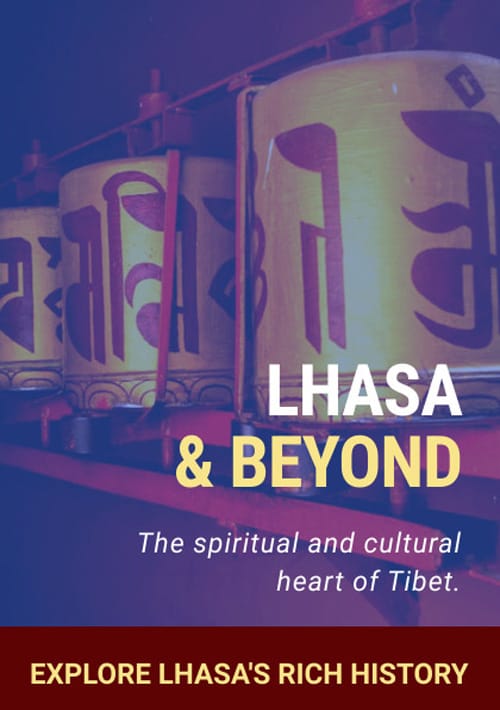
Lhokha is also called Shannan, located in the southeast of Tibet, the birthplace of Tibetan civilization. It is one of the most historic area in Tibet, with ancient monasteries, sacred valleys and stunning scenery. The region is rich in Tibetan culture, you can get history, spirituality and nature all in one. Whether you are history buff, nature lover or spiritual seeker, Lhokha has everything for you.
Lhokha’s importance is not only in its scenery but also in its cultural and religious background. It is the birthplace of Tibetan civilization, where the first Tibetan king, Nyatri Tsenpo, established the Yarlung dynasty over 2,000 years ago. The Yarlung Valley is called the “cradle of Tibetan culture”, has ancient ruins and sacred sites, many of which have been important to Tibetan history and spirituality.
Visitors to Lhokha will find a mix of Tibetan culture, natural scenery and spiritual atmosphere. The region has monasteries, including the famous Samye Monastery and stunning views of the Himalayas and Yarlung Tsangpo River which runs through the valley.
Samye Monastery: One of the most famous and historic monasteries in Tibet, Samye Monastery is a must see for any one who travel to Lhokha. Built in 8th century by King Trisong Detsen, Samye is the first Buddhist monastery in Tibet. It was the place where Tibetan Buddhism spread and the first Buddhist debate in Tibet took place. The monastery’s unique Tibetan style architecture with a central mandala and peaceful atmosphere is a spiritual and cultural highlight.
Yarlung Valley: Called the birthplace of Tibetan civilization, Yarlung Valley is the heart of Lhokha. It has many ancient Tibetan ruins, including the tombs of the first Tibetan kings. The valley is green and fertile, with terraced fields and winding rivers. It’s a trekker’s paradise and a must see for those who want to explore the historical and cultural sites of Tibet.
Tsetang: Tsetang is the capital city of Lhokha and the entrance of the region for travelers. It’s located on the bank of Yarlung Tsangpo River and has a peaceful atmosphere with the surrounding mountains view. You can visit Tsetang Palace, a historic site which was once the palace of Tibetan kings and explore the local market and Tibetan culture.
Chimphu Caves: For those interested in Tibetan Buddhism and meditation, Chimphu Caves is a spiritual experience. Located near Samye Monastery, these caves were used by Tibetan saints for meditation and spiritual practice. The peaceful environment and valley view is a great place for contemplation.
Yumbulagang Palace: Another historical site in Lhokha, Yumbulagang Palace is believed to be the first royal palace in Tibet. It’s situated on a hill with panoramic view of Yarlung Valley. A pilgrimage site and a glimpse into the ancient Tibetan kingdom.
The best time to visit Lhokha is in spring (April to June) and autumn (September to November). In these months the weather is mild and the landscapes are most beautiful. Spring has blooming flowers and clear sky, autumn has golden color as the harvest season approaches.
Winter (December to February) is very cold in Lhokha, especially at higher altitude, temperature can drop below freezing. But if you are prepared for the cold and want fewer tourists, winter can be a quiet and peaceful experience.
Acclimatization: Lhokha is at an altitude of 3,600 meters (11,800 feet) above sea level and high altitude can cause altitude sickness. It’s recommended to spend a few days in Lhasa or other lower altitude area before traveling to Lhokha to acclimatize. Stay hydrated, avoid heavy physical activity on arrival and watch for symptoms of altitude sickness such as dizziness, nausea or headache.
Permits: As Lhokha is in Tibet, travelers need to have the right permits to visit. TTP (Tibet Travel Permit) is mandatory for all foreign visitors and additional permits may be required for certain areas. It’s recommended to arrange your permits in advance through a licensed travel agency in Lhasa that specializes in Tibet tours.
Transportation: Lhokha is 200 km from Lhasa and can be reached by road. The road is generally good but traveling in remote areas can be challenging, so it’s highly recommended to hire a local guide or join a tour group. There are also buses between Lhasa and Tsetang, the capital of Lhokha.
Cultural Etiquette: Tibetans are very proud of their culture and religion, so be respectful when visiting religious sites. When entering monasteries, always remove your shoes and don’t touch sacred objects. When taking photos, ask for permission first, especially when taking photos of people or religious ceremonies.
Pack Wisely: The weather in Lhokha can be unpredictable, so pack accordingly. Bring warm clothing for cold night and early morning even in summer. Comfortable shoes are a must, especially if you plan to visit monasteries and temples or trekking. Also, bring a good camera to capture the beautiful landscapes and spiritual sites.
Lhokha is a destination that has history, scenery and spirituality. Whether you are interested in ancient temples, Himalayan views or experiencing Tibetan culture up close, Lhokha has something for every traveler. Follow these travel tips and you will have a smooth and enjoyable journey to this part of Tibet.
Tibet Holiday is a premier Tibet travel agency offering personalized tours to explore the rich culture and stunning landscapes of Tibet. With nearly 20 years of experience, our dedicated team of local experts provides unique insights into Tibetan traditions and spiritual sites. Committed to sustainable travel, we collaborate with local businesses, ensuring an authentic and enriching experience. Whether seeking adventure or cultural exploration, Tibet Holiday designs custom journeys tailored to your interests, making it a trusted choice for unforgettable Tibet experiences.